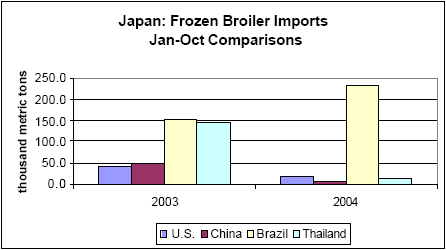



International Egg and Poultry Review
By the USDA's Agricultural Marketing Service - This is a weekly report looking at international developments concerning the poultry industry, this week looking at China and Japans poultry.
Japan's Poultry
Outbreaks of avian influenza dramatically changed Japan’s trade patterns
in 2004. Japan sharply curtailed poultry imports from China and
Thailand due to outbreaks of Highly Pathogenic Avian Influenza (HPAI).
Several cases of low path avian influenza in the U.S. interrupted poultry
shipments to Japan. The U.S. found HPAI in a small flock, a different
type than was found in Asia, and Japan placed restrictions on the affected
state.
Poultry imports from China were halted after HPAI was confirmed in
China. Japan's Chinese imports fell from 6,786 MT in January to 935
MT in February to zero for March and April. For the first 10 months in
2004, imports of frozen broilers totaled 8,375 MT compared to 51,274
for the same period in 2003. There were no imports of fresh or chilled
broilers from China for February through October 2004.
Japan imported 12,190 MT of frozen broilers from Thailand in January
2004, before Thailand confirmed outbreaks of HPAI. For the next nine
months, only 59 metric tons more were imported, totaling 12,249 MT
for January through October 2004. Broiler imports from Thailand
reached 146,467 MT for January through October 2003.
January through October 2004 broiler imports from the U.S. fell to 19,886
MT compared to 42,699 MT for the same period in 2003. Imports declined
sharply in February and again for April through July, recovering in
August. Japan reacted to the presence of low path avian influenza in
the U.S. by immediately halting imports, only to resume most imports
once the strain of avian influenza was confirmed to be low path.
Brazil was the major beneficiary of Japan’s bans on poultry imports
from China, Thailand and the U.S. Japan’s poultry imports from Brazil
grew from 152,580 MT for the first ten months in 2003, to 232,419 MT
for the same period in 2004.
Source: ALIC, OIE, news wires

China
China is recovering from an outbreak of highly pathogenic avian
influenza (HPAI) in January 2004. China quickly culled over 9 million
birds to contain the disease and on March 19, 2004 announced no new
outbreaks had been reported in 32 days. In early July, China reported a
single case of HPAI on a relatively isolated farm in Anhui province.
China cleared the area through vaccination, culling and surveillance.
According to the China’s Ministry of Agriculture (MOA), poultry production
in the first quarter fell four percent. Total poultry production for the first
half of 2004 recovered to a net decline of one percent. For 2005, China’s
poultry production is forecast to recover to 9.9 MMT, about the same as
pre-avian influenza 2003 level.
Imports are estimated to fall 55 percent in 2004 due to decreased U.S.
imports. China banned U.S. poultry imports in February 2004, due to
avian influenza in the U.S. and increased imports from Brazil and
Argentina.
China’s broiler meat exports are recovering. Japan, China’s largest
export market, reopened its cooked broiler market to China. Hong Kong,
China’s second largest export market, fully reopened for all kinds of
broiler products.

The challenge is to prevent HPAI from reoccurring in China. Viet Nam
and Thailand both reported outbreaks in January 2005. Chinese
authorities established an 18 mile wide “immune protection zone” along
the 746 mile border between Yunnan Province and Viet Nam. Stations
were set up to inspect and disinfect all vehicles and people passing
through the area.
This year the Chinese New Year falls on February 9, with New Year’s
Eve celebrations on February 8. Also called the Spring Festival, this is
the largest holiday in Chinese culture and chicken is served at most
meals. Movement of poultry and poultry products will increase. The
travel season begins on January 27 and runs for 40 days. Tens of
millions of Chinese travel to their hometowns. Hundreds of thousands
of Chinese migrant workers travel from the large cities to their rural
homes for the holiday.
Hong Kong normally allows 30,000 live birds to be imported daily from
the mainland. Import quotas for January 30 through February 4 were
relaxed to allow 50,000 birds daily and the quota will be lifted February
5 through February 7 to allow consumers to stock up before the three
day holiday that begins on February 8.
Source: OIE, USDA/FAS, FAOAIDEnews, news wires
To view the full report, including tables please click here (PDF Format)
Source: USDA's Agricultural Marketing Service - 1st February 2005








